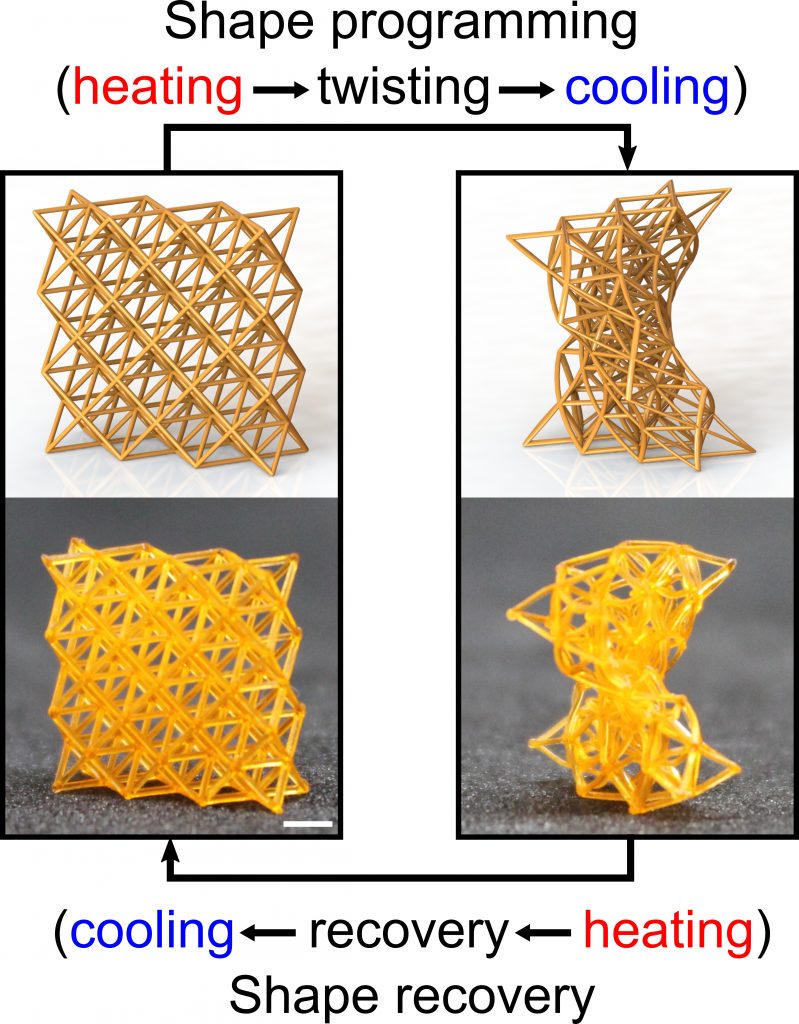 Engineers at Rutgers University–New Brunswick are advancing beyond the realm of 3D printing, now fabricating smart materials in 4D that will transform as needed, according to their environment. Such structures could become transforming for numerous high-level applications, with shock-absorbing materials that will change as needed, for use in examples such as: aircraft or drone design for parts like wings that need to self-alter for varying performance, soft robotics meant to perform a wide range of tasks, and tiny, minimally invasive medical implants.
Engineers at Rutgers University–New Brunswick are advancing beyond the realm of 3D printing, now fabricating smart materials in 4D that will transform as needed, according to their environment. Such structures could become transforming for numerous high-level applications, with shock-absorbing materials that will change as needed, for use in examples such as: aircraft or drone design for parts like wings that need to self-alter for varying performance, soft robotics meant to perform a wide range of tasks, and tiny, minimally invasive medical implants.
Findings regarding this latest research are outlined in ‘4D Printing Reconfigurable, Deployable and Mechanically Tunable Metamaterials.’ As the researchers explain, most metamaterials, as exotic and mechanically-tuned as they may be, are composed of fixed properties and are not able to adapt to many of the specific needs that users have today. With so much progressive technology at our fingertips, it really doesn’t seem to be too much to ask for materials to bend to our will. The Rutgers scientists don’t disappoint here either, creating complex geometries that are:
- Geometrically reconfigurable
- Functionally deployable
- Mechanically tunable
- Unique and lightweight
“Using digital micro 3D printing with a shape memory polymer, dramatic and reversible changes in stiffness, geometry, and functions of metamaterials are achieved,” state the researchers in their paper, authored by Howan Lee, Chen Yang, Manish Boorugu, Andrew Dopp, Jie Ren, Raymond Martin and Daehoon Han, all current or former Rutgers students, and Professor Wonjoon Choi at the Korea University.
Typical triggers in 4D printed materials are changes in temperature, exposure to moisture, and the amount of time elapsed. Materials, often made with different polymer-like substances, will remain rigid if pushed down—or they can become pliable and absorbent, functioning to absorb impact and shock. The scientists working on the project say that such materials can be transformed and deformed—and then they will revert upon exposure to heat.

4D printed metamaterials can be temporarily transformed into any deformed shape and then returned to their original shape on demand when heated. The scale bar is 2 millimeters. (Photo credit: Chen Yang/Rutgers University-New Brunswick)
“The stiffness can be adjusted more than 100-fold in temperatures between room temperature (73 degrees) and 194 degrees Fahrenheit, allowing great control of shock absorption,” states the research team.
“We believe this unprecedented interplay of materials science, mechanics and 3D printing will create a new pathway to a wide range of exciting applications that will improve technology, health, safety and quality of life,” says senior author Howon Lee, assistant professor in the Department of Mechanical and Aerospace Engineering.
While 3D printing is still taking the world by storm, from the DIY crowd to the upper echelons of industrial manufacturing from GE to NASA, technology has already evolved to the next level with 4D printing. Just as 3D printing offers the potential for incredible customization, like medical innovations that will allow for patient-specific care, 4D printing allows for materials to morph into desired shapes and textures for creations such as load-bearing structures, seating in luxury vehicles, and so much more—to include many forays into fashion like clothing and wearables.
What do you think of this news? Let us know your thoughts! Join the discussion of this and other 3D printing topics at 3DPrintBoard.com.
[Source / Images: Rutgers news release]Subscribe to Our Email Newsletter
Stay up-to-date on all the latest news from the 3D printing industry and receive information and offers from third party vendors.
You May Also Like
Changing the Landscape: 1Print Co-Founder Adam Friedman on His Unique Approach to 3D Printed Construction
Additive construction (AC) is much more versatile than it seems, at first: as natural as it is to focus on the exciting prospect of automated home construction, there’s far more...
US Army Corps of Engineers’ Megan Kreiger on the State of Construction 3D Printing
Despite last year’s gloomy reports about the financial state of the additive manufacturing (AM) industry, there’s no doubt that we’re actually witnessing the birth of a sector rather than its...
3D Printing Webinar and Event Roundup: April 21, 2024
It’s another busy week of webinars and events, starting with Hannover Messe in Germany and continuing with Metalcasting Congress, Chinaplas, TechBlick’s Innovation Festival, and more. Stratasys continues its advanced training...
Profiling a Construction 3D Printing Pioneer: US Army Corps of Engineers’ Megan Kreiger
The world of construction 3D printing is still so new that the true experts can probably be counted on two hands. Among them is Megan Kreiger, Portfolio Manager of Additive...






























